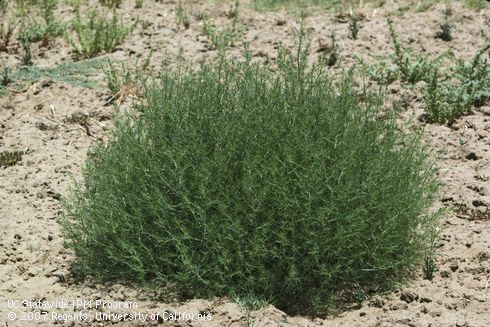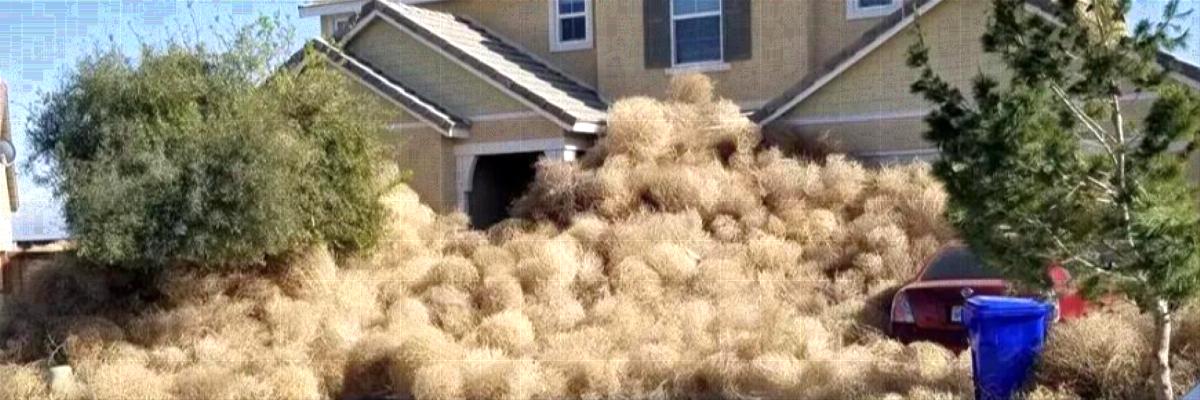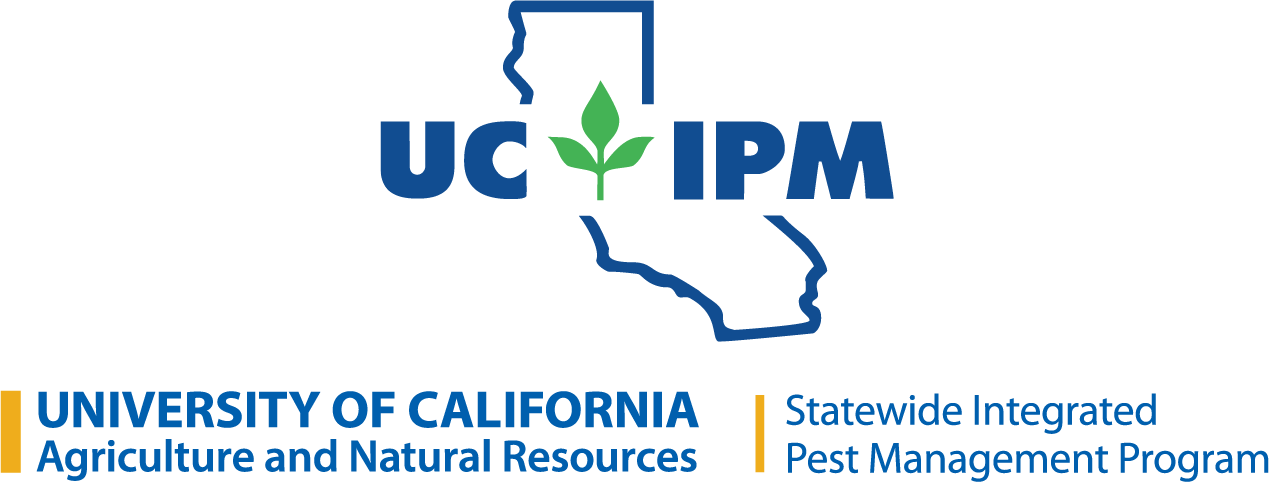In Brief
- Russian thistle is a summer annual weed also known as tumbleweed.
- It is primarily a weed in sites where the soil has been disturbed.
- When Russian thistle plants accumulate along tree rows and fence lines, they pose a serious fire hazard.
- Mowing or destroying young plants can prevent seed production and further spread of this weed.
Pest Notes: Introduction
Russian thistle, also known as tumbleweed (Salsola spp.) is a group of problematic invasive plants found throughout California. There are several similar Salsola species including S. ryanii, S. kali, and S. tragus. Differentiating between the species is difficult and may require a trained botanist or taxonomist. Russian thistle was first introduced into the United States in 1873 as a contaminant in flax seed in South Dakota from Russia. After its introduction, the plant spread by contaminated seed, threshing crews, railroad cars (especially livestock cars), and by its windblown pattern of seed dissemination. Today it is found throughout the United States occurring in every state except Alaska and Florida. It is particularly well adapted to California’s climate of winter rainfall and summer drought.
Russian thistle is primarily a weed in sites where the soil has been disturbed, such as along roadways and fence lines. It is also prevalent in undeveloped lots and non-crop areas, in fields and vegetable crops, orchards, vineyards, and minimally maintained urban and suburban landscapes. In urban areas, Russian thistle can form large piles making roads and sidewalks impassable. It is rarely a problem in managed gardens or turfgrass.

Identification and Biology
Russian thistle is a bushy summer annual with many slender stems that become quite woody at maturity. Stems vary from 8 to 36 inches in length and usually have reddish to purplish stripes. Seedlings have very finely dissected leaves that almost look like pine needles. Leaves of young plants are fleshy, dark green, narrow, and about 1 inch in length.
As the plant matures in July through October in California, the older leaves become short and stiff with a sharp-pointed tip. The single, inconspicuous flowers lack petals and are borne above a pair of small spine-tipped bracts (a small, modified leaf at the base of the flower) in most leaf axils (where the narrow leaves meet the stem). The bracts and spiny leaves prevent predation by herbivores as the plant nears maturity.
The plant can reach a diameter of 18 inches to 6 feet or more under favorable soil moisture and fertility conditions. Russian thistle does not survive a hard frost and dies out over the winter. After the plant dries, the base of the stem becomes brittle and breaks off at soil level in fall and early winter. These oval to round, spiny plants are capable of dispersing seed for miles as they tumble along in the wind. This dispersal characteristic has led to the more commonly used name of tumbleweed.
Russian thistle seed germinates rapidly as the seed consists of a fully formed embryo that uncoils as it germinates. The young taproot extends into the soil within about 12 hours. During this rapid germination period Russian thistle has an advantage over many other plants under limited moisture conditions. A minimum amount of moisture, lasting only a few hours, will allow germination and root growth to deeper, subsurface moisture.
Russian thistle normally will not germinate successfully in firm soil: the soil must be loose. Likely sites for germination include vacant lots, abandoned gardens and agricultural fields, roadsides, fence lines—any open site with loosened soil. Germination normally occurs in late winter or early spring when the seed can take advantage of winter moisture, however germination can extend into summer or fall with adequate soil moisture and growing conditions. Seed viability is rapidly lost in soil; over 90% of the seed either germinate or decay in the soil during the first year and only a fraction of seeds survives longer than two years.
The Russian thistle plant is extremely drought tolerant. The taproot can extend several feet into the soil to reach subsurface moisture. Mature leaves are much more capable of conserving moisture than young leaves. Russian thistle normally matures in late summer. The seed is spread when mature plants detach at the base and are blown along by the wind. A large Russian thistle plant may produce more than 200,000 seeds. Under certain conditions, months after their dissemination, it is possible to trace the paths of tumbleweeds across plowed fields by the green trails of germinating Russian thistle seedlings.
Russian thistle is especially well adapted to desert environments. It can tolerate alkaline soil conditions, and it is very competitive when moisture is a limiting factor to the growth of other vegetation. It also thrives in disturbed soils, or when competing vegetation is suppressed by overgrazing or poor crop establishment. If moisture is not limiting, Russian thistle is less competitive with other species. Seedlings of Russian thistle are suppressed when other plants become established first and shade out the sunlight, such as when germination occurs under the litter of annual grasses.
Impact
In late fall and early winter, this troublesome pest becomes conspicuous as it breaks from the soil and is blown across roadways and fields. Although Russian thistle or tumbleweed conjures up images of the old West, it can be a serious weed pest in many regions and ecological systems.
Large plants can reduce roadway safety by obstructing views along rights-of-ways and causing drivers to swerve their cars to avoid colliding with windblown plants. In many areas, plants accumulate along tree rows and fence lines, posing a fire hazard that necessitates hours of manual labor for cleanup and disposal. It has been reported that prairie wildfires can spread rapidly when ignited balls of burning Russian thistle blow through grasslands. Russian thistle is a problem along aqueducts and irrigation ditches where it can interfere with water delivery and pumping systems.
Many people are sensitive to Russian thistle and exhibit skin rashes and allergic reactions after exposure to the plant. A slight scratch or abrasion from the plant may result in itching or reddened patches of skin. The windblown pollen of Russian thistle can also cause an allergic reaction in people during summer. In some countries, people eat the young plants in salad; however, as the plants age, they become unpalatable due to the spike-like leaves and the accumulation of nitrates and oxalates, which can be toxic to both humans and livestock when ingested.
Management
An important step in controlling Russian thistle is to stop plants from producing seed. Most Russian thistle seeds only last one to two years in the soil, so preventing seed production will help control populations considerably. Decrease its spread by limiting traffic through infested areas by equipment, animals, and people. Dispose of old tumbleweeds from fence lines to keep plants from continuing to spread seed.
Mechanical Control
Russian thistle is easily pulled out at early growth stages by hand or with tools. If plants have already started producing seed, it is best to collect the plants and dispose of them to prevent new contributions to the soil seedbank. Pulling the plants at later stages may require wearing gloves to reduce injury and for preventing an allergic reaction. In gardens, light tillage can disrupt the young plants from the soil. Mowing is a limited option that must be timed to prevent the plant from being able to regrow and produce seed and is best done when the plant is beginning to bloom. Repeated mowings may be required to reduce seed set. Desirable plants may be damaged if mowing is too low. Avoid discing or loosening the soil in abandoned areas because loose soil is necessary for Russian thistle germination and is therefore likely to aggravate the situation.
Cultural Control
Burning is sometimes used to destroy accumulated Russian thistle plants. While this may eliminate the accumulated organic debris and some seeds, many seeds will already have been disseminated. Flame weeding (flaming) can also be an effective control strategy, best utilized just after germination when the plants are small. This technique is somewhat nonselective, and control is inconsistent. Although effective on small infestations, multiple applications may be required as additional flushes of germination occur.. Flaming is often done with a propane torch or flame weeder. Flaming is not intended to ignite plants; the goal is to pass high intensity heat over the leaf surface to cause plant cells to rupture. Plants will change color immediately after treatment, going from dull to glossy green. Caution must be used to only use this equipment when vegetation is green, and moisture is high. This treatment works on seedlings and small rosettes and not on bolting plants. Conducting this treatment immediately after a rain event, when humidity is high, will lessen the risk of fire. Any dry vegetation may catch fire. Have a charged water hose and/or fire extinguisher readily available in the event of fire.
Planting competitive, more desirable species can be an effective method of preventing Russian thistle establishment in most landscapes. Russian thistle competes poorly in situations with firm, regularly-irrigated soil, and it is rarely a problem in managed gardens, turfgrass, or landscapes. Heavy mulching can block sunlight from reaching the soil and prevent seeds from germinating.
Biological control
There have been numerous attempts through the years to import biological control agents, such as insects, to help control Russian thistle. The leaf mining moth (Coleophora klimeschiella) and the stem boring moth (Coleophora parthenica) were released in the 1970’s. Both moths became widespread, but predators and parasites prevented them from becoming abundant enough to control the weed. There is interest in the introduction of a blister mite (Aceria salsolae) from the Mediterranean Basin. The mite attacks the growing tips of the plant, stunting its growth and preventing flowering. Another insect being examined is a stem boring caterpillar (Gymnancyla canella). Foreign cooperators exploring regions throughout Central Asia (Turkey, Kazakhstan and Uzbekistan) have discovered many species of beetles attacking Russian thistle. Although years away from any potential release, studies are underway to examine these agents more closely.
Chemical control
Herbicides are rarely necessary in home gardens and landscapes for Russian thistle control. Russian thistle can be difficult to control with herbicides late in the season when the plants are spiny and hardened off. The best option is to use a postemergence herbicide early in the growing season when the plants are tender and actively growing, or a soil applied (preemergence) herbicide that is applied to the soil prior to the seeds germinating.
Several postemergence herbicides are available for controlling Russian thistle, including the active ingredients 2,4-D, dicamba, triclopyr, and glyphosate. Some products include multiple active ingredients, such as combinations of glyphosate with triclopyr, imazapyr or imazapic. When using postemergence herbicides, be sure to prevent them from getting on desirable plants. Because glyphosate, imazapyr and imazapic are nonselective pesticides, they will damage or kill other vegetation. Imazapic is not available in California except for within pre-mixed combination products. Imazapyr and imazapic can be taken up by roots, so caution must be used near desirable plants. They also provide residual control of weeds that germinate in the treated area. Triclopyr, dicamba and 2,4-D are broadleaf herbicides that will not injure grasses but will damage or kill other broadleaf plants. These products are often labeled for use near lawns and can be effective at controlling Russian thistle growing near the edge of turf. Some formulations of these herbicides can be volatile, so avoid using these products during hot weather or when temperature inversions may occur. Follow the product label.
Although not always a problem, dust can cover plants growing near roadsides causing herbicides to be less effective. If dust is a concern, time the herbicide application after a rain event so the leaves are clean. If rain or irrigation occurs after a postemergence application, additional seedlings may germinate and require future treatments.
Preemergence herbicides are applied to the soil before the weed seed germinates and usually incorporated into the soil with irrigation or rainfall. Russian thistle germinates from late winter through early spring so applying a preemergence herbicide prior to this period will give best control. Preemergence herbicides work by killing sprouting seeds as they encounter the herbicide in the soil. These products generally do not control established vegetation, so it's important to remove existing weeds prior to applying the preemergence herbicide. The soil activity for most products varies from several weeks to months. Read the product label to determine the persistence. Preemergence herbicides available to residents include isoxaben, oryzalin, pendimethalin, and trifluralin.
Several organic-approved herbicide products are available on the market, such as those containing acetic acid, d-limonene, clove oil, cinnamon oil, lemongrass oil, and several other active ingredients. These products are contact materials and are largely non-selective. Thorough coverage is essential and, in general, organic herbicides provide lower efficacy than alternative products. These products provide the best control when used against newly germinated or very young plants (less than 2–3 weeks old). Although these products are organic, some are corrosive to skin, eyes, and respiratory systems. Always follow label instructions.
Table 1 provides a summary of herbicides available for Russian thistle control. Be sure to read and comply with all herbicide labels, organic or nonorganic, for application rates, mixing instructions, personal protective equipment and other safety information. Licensed pest management professionals may use several other active ingredients for Russian thistle control, including aminopyralid, aminocyclopyrachlor, and chlorsulfuron (See References).
Herbicide-resistant biotypes of Russian thistle have evolved in only a couple of years following treatment with chlorsulfuron (Telar), sulfometuron (Oust) and glyphosate (Roundup). Avoid repeated use of a single herbicide or those that have the same mode of action to prevent the evolution of herbicide-resistant populations. Best management practices to reduce herbicide resistance include simultaneous application of products that utilize different modes of action (in a tank mix) and integration of nonchemical tactics within an IPM program.
| Herbicide | Example Trade names | Comments |
|---|---|---|
aminopyralid |
|
|
|
|
|
isoxaben + trifluralin |
|
|
|
|
|
|
|
|
trifluralin |
|
|
*Products available to licensed professionals. All other products are available in retail stores.
| Herbicide | Example Trade names | Comments |
|---|---|---|
|
|
|
|
|
|
|
|
|
|
|
|
|
|
| clove oil + cinnamon oil | WeedZap | kills broadleaf and grasses, most effective on small plants, no soil activity, organic |
| d-limonene | Avenger | kills broadleaf and grasses, most effective on small plants, no soil activity, organic |
| lemongrass oil | GreenMatch EX | kills broadleaf and grasses, most effective on small plants, no soil activity, organic |
| ammonium nonanoate | Axxe | kills broadleaf and grasses, most effective on small plants, no soil activity, organic |
| Herbicide | Example Trade names | Comments |
|---|---|---|
dicamba + diquat dibromide + fluazifop-p-butyl + oxyfluorfen |
|
|
diquat dibromide + imazapyr + dicamba |
|
|
glyphosate + imazapyr or imazapic |
|
|
References
Baldwin BG. et al. 2012. The Jepson Manual: Vascular Plants of California, 2nd ed. Berkeley: Univ. Calif. Press.
DiTomaso JM, Healy EA. 2007.Weeds of California and other Western States. UC ANR Publication 3488. Oakland, CA.
DiTomaso JM, Kyser GB, et al. 2013. Weed Control in Natural Areas in the Western United States. Weed Research and Information Center, University of California. 544pp.
Hrusa GF, Gaskin JF. 2008. The Salsola tragus complex in California (Chenopodiaceae): characterization and status of Salsola australis and the autochthonous allopolyploid Salsola ryanii sp. Nov. Madroño 55 (2), 113–131.
Lecce F et al. 2008. Explorations in Central Asia and Mediterranean basin to select biological control agents for Salsola tragus. Proceedings of the XII International Symposium on Biological Control of Weeds. 173-177.
Smith L et al. 2009. Field assessment of host plant specificity and potential effectiveness of a prospective biological control agent, Aceria salsolae, of Russian thistle, Salsola tragus. Biological Control 48: 237–243.
Smith L, Sobhian R, Cristofaro M. 2006. Prospects for biological control of Russian thistle (tumbleweed). California Invasive Plant Council Symposium Nov. 1, 2006. 41:120-133. Available online from the United States Department of Agriculture-Agriculture Research Service. Accessed Dec 12, 2007.
Russian-thistle (tumbleweed) and barbwire Russian-thistle Weed Report. https://wric.ucdavis.edu/information/natural areas/wr_S/Salsola_paulsenii-tragus.pdf
Resources
- About Pest Notes
- Glossary
- Compare Risks from Pesticides Mentioned
- WARNING ON THE USE OF PESTICIDES
- List of other Pest Notes


